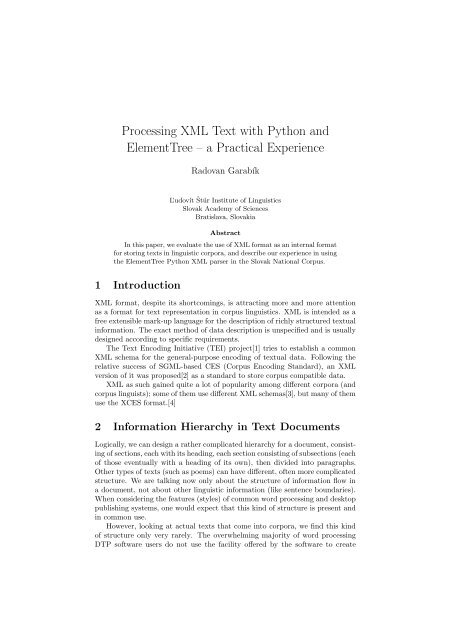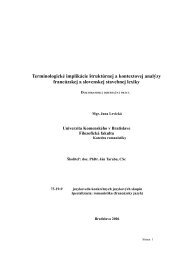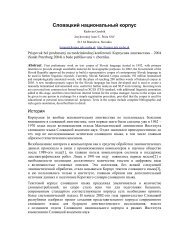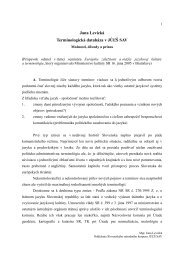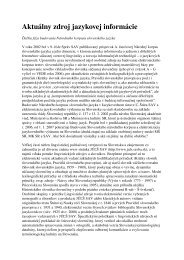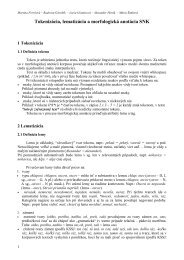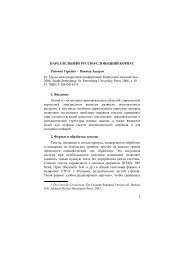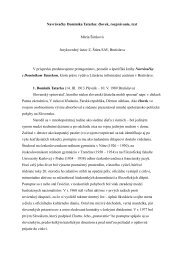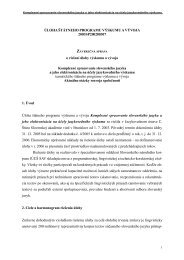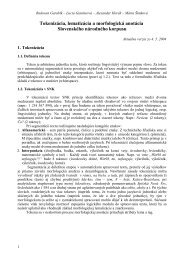Processing XML Text with Python and ElementTree – a Practical ...
Processing XML Text with Python and ElementTree – a Practical ...
Processing XML Text with Python and ElementTree – a Practical ...
You also want an ePaper? Increase the reach of your titles
YUMPU automatically turns print PDFs into web optimized ePapers that Google loves.
<strong>Processing</strong> <strong>XML</strong> <strong>Text</strong> <strong>with</strong> <strong>Python</strong> <strong>and</strong><br />
<strong>ElementTree</strong> <strong>–</strong> a <strong>Practical</strong> Experience<br />
Radovan Garabík<br />
L’udovít ˇ Stúr Institute of Linguistics<br />
Slovak Academy of Sciences<br />
Bratislava, Slovakia<br />
Abstract<br />
In this paper, we evaluate the use of <strong>XML</strong> format as an internal format<br />
for storing texts in linguistic corpora, <strong>and</strong> describe our experience in using<br />
the <strong>ElementTree</strong> <strong>Python</strong> <strong>XML</strong> parser in the Slovak National Corpus.<br />
1 Introduction<br />
<strong>XML</strong> format, despite its shortcomings, is attracting more <strong>and</strong> more attention<br />
as a format for text representation in corpus linguistics. <strong>XML</strong> is intended as a<br />
free extensible mark-up language for the description of richly structured textual<br />
information. The exact method of data description is unspecified <strong>and</strong> is usually<br />
designed according to specific requirements.<br />
The <strong>Text</strong> Encoding Initiative (TEI) project[1] tries to establish a common<br />
<strong>XML</strong> schema for the general-purpose encoding of textual data. Following the<br />
relative success of SGML-based CES (Corpus Encoding St<strong>and</strong>ard), an <strong>XML</strong><br />
version of it was proposed[2] as a st<strong>and</strong>ard to store corpus compatible data.<br />
<strong>XML</strong> as such gained quite a lot of popularity among different corpora (<strong>and</strong><br />
corpus linguists); some of them use different <strong>XML</strong> schemas[3], but many of them<br />
use the XCES format.[4]<br />
2 Information Hierarchy in <strong>Text</strong> Documents<br />
Logically, we can design a rather complicated hierarchy for a document, consisting<br />
of sections, each <strong>with</strong> its heading, each section consisting of subsections (each<br />
of those eventually <strong>with</strong> a heading of its own), then divided into paragraphs.<br />
Other types of texts (such as poems) can have different, often more complicated<br />
structure. We are talking now only about the structure of information flow in<br />
a document, not about other linguistic information (like sentence boundaries).<br />
When considering the features (styles) of common word processing <strong>and</strong> desktop<br />
publishing systems, one would expect that this kind of structure is present <strong>and</strong><br />
in common use.<br />
However, looking at actual texts that come into corpora, we find this kind<br />
of structure only very rarely. The overwhelming majority of word processing<br />
DTP software users do not use the facility offered by the software to create
(or use those already existing) logical styles to format the document, but apply<br />
physical text attributes to the document parts instead <strong>–</strong> so, for example, the<br />
headers are distinguished from the rest of the text only by changes in font size<br />
or font weight. This makes it almost impossible to use universal tools to extract<br />
logical structure from the documents. Often, only very basic structure can be<br />
identified <strong>and</strong> kept in the corpus.<br />
3 Various Levels of <strong>Text</strong> Representation<br />
There are actually two different ways of putting texts into the XCES format.<br />
One way is to use <strong>XML</strong> tags to mark up the hierarchical structure of text<br />
flow <strong>and</strong> typographical information. The other way is to use <strong>XML</strong> to organise<br />
basic structural elements of the texts (usually words) together <strong>with</strong> additional<br />
linguistic information into a rigid structure for further processing <strong>–</strong> in this way,<br />
we are using <strong>XML</strong> format as a (rather inefficient) way of emulating a tabular<br />
format.<br />
4 Why <strong>Python</strong><br />
Our programming language of choice is <strong>Python</strong>[5], a high level object oriented<br />
programming language <strong>with</strong> a very clean syntax. Typically, using <strong>Python</strong> for<br />
software development leads to very short deployment times when compared<br />
<strong>with</strong> others, better promoted languages. The clarity of the syntax also contributes<br />
to very few language-oriented bugs in the software, leaving more time<br />
for debugging <strong>and</strong> optimalisation of the algorithms used. <strong>Python</strong> also has an<br />
excellent st<strong>and</strong>ard library, covering most of the routine programming tasks connected<br />
<strong>with</strong> interfacing various levels of the operating system, user interaction<br />
<strong>and</strong> robust data manipulation. There are also many other external libraries<br />
(modules) covering more specialised tasks, <strong>and</strong> connecting to existing libraries<br />
in other programming languages (most notably C <strong>and</strong> C++) is easy, insofar as<br />
programming in C or C++ is easy.<br />
The disadvantages of using <strong>Python</strong> stem mostly from the fact that it is an<br />
interpreted language, <strong>with</strong> the consequent negative effects relating to speed of<br />
execution. While several <strong>Python</strong> compilers, optimisers <strong>and</strong> JIT-compilers have<br />
been designed, at least theoretically, only Psyco[6] seems mature enough for<br />
production use, <strong>and</strong> its performance gain is not very impressive <strong>–</strong> thanks to<br />
<strong>Python</strong>’s dynamic nature.<br />
5 Structure of Data in the Slovak National Corpus<br />
<strong>Text</strong>s coming into the corpus are put into a hierarchical structure, each level<br />
corresponding to a different stage of text conversion <strong>and</strong> processing. Initially,<br />
texts are stored in the Archive in their original format. The texts are then converted<br />
into common text format, keeping some typographic information present<br />
in the original sources. We call this level of text processing the Bank. The data<br />
are then cleaned up <strong>and</strong> additional linguistic information is added to them, <strong>and</strong>
the files are placed in the next level called the Corpusoid. The final step in data<br />
processing is a level called simply the Data, where the data are converted into<br />
binary format for the corpus manager.<br />
File format in the Bank is in fact a simple subset of XCES-conforming <strong>XML</strong>.<br />
The files from the Archive are converted into this common Bank-format <strong>and</strong><br />
these files are then converted on their way to the Corpusoid In the Corpusoid,<br />
texts are already tokenised, tokens are grouped into sentences, <strong>and</strong> each token<br />
contains additional information about lemma <strong>and</strong> morphosyntactic categories.<br />
Therefore, <strong>XML</strong> is used here to implement this tabular-like structure.<br />
6 Using <strong>ElementTree</strong><br />
<strong>ElementTree</strong>[7], by Fredrik Lundh, is a <strong>Python</strong> implementation of an <strong>XML</strong><br />
structure representation, in DOM-like style. The whole tree structure is represented<br />
by an <strong>ElementTree</strong> object, which can be created from scratch or read<br />
from an existing <strong>XML</strong> file. Parsing an <strong>XML</strong> file can be done in one line of code:<br />
tree = <strong>ElementTree</strong>.parse(’filename.xml’)<br />
Similarly, writing in-memory representation of an <strong>XML</strong> structure to a file can<br />
be done in this way:<br />
tree.write(file(’output_filename.xml’, ’w’), encoding=’utf-8’)<br />
Each <strong>XML</strong> node is represented by a dictionary-like object of an Element class.<br />
It is possible to loop through children of the node, to find a given subnode, to<br />
query attributes of the node or to modify any of these in place. In order to<br />
start working <strong>with</strong> nodes, we have to create a reference to a top-level node in<br />
our <strong>XML</strong> structure:<br />
root = tree.getroot()<br />
root is now an Element object. Let’s take as an example the following piece of<br />
an <strong>XML</strong> file:<br />
Paragraph <strong>with</strong> a highlighted word.<br />
This will be represented in Elementtree as an Element class <strong>with</strong> the following<br />
attributes (some are omitted for brevity):<br />
element.name == ’p’<br />
element.text == ’Paragraph <strong>with</strong> a ’<br />
element.attribs = {’style’:’plain’}<br />
element.tail = None<br />
element.children = [hi_element]<br />
where hi element is another Element class:<br />
element.name == ’hi’<br />
element.text == ’highlighted’<br />
element.attribs = {}<br />
element.tail = ’word.’<br />
element.children = []
The problem <strong>with</strong> this approach is obvious: while the text after the highlighted<br />
part in our example is logically <strong>and</strong> structurally on the same level as<br />
the rest of the text, in Elementtree <strong>XML</strong> representation it has been put into<br />
the element as a tail attribute, creating a lot of problems when trying to<br />
program a way of iterating through the text, because suddenly one has to be<br />
aware that parts of the text can be hidden in subordinate elements <strong>–</strong> <strong>and</strong> we<br />
have go into arbitrary depths.<br />
In fact, as our experience in parsing the bank format shows, this problem is<br />
really intimidating. We had to use complicated solutions, often including careful<br />
recursion into subnodes, <strong>and</strong> we learned that it is almost impossible to modify<br />
the document structure in place, because one has to be careful about putting<br />
the tail elements into the correct places when eliminating, adding or otherwise<br />
modifying the children nodes.<br />
Fortunately, we need not to deal <strong>with</strong> the texts on this level, the only thing<br />
we have to do <strong>with</strong> texts in the Bank is to tokenise them <strong>and</strong> transform them<br />
into the XCES Corpusoid files.<br />
Looking on the bright side, <strong>ElementTree</strong> turned out to be a very useful<br />
representation of XCES files in the corpusoid. Each token is represented by<br />
a node, containing several subnodes describing the token. At the first<br />
stage, just after converting the text from bank into XCES format, there is just<br />
an subnode <strong>with</strong> original wordform as a text attribute:<br />
<br />
meč<br />
<br />
The text is then lemmatised <strong>and</strong> morphologically annotated. We are using<br />
the software described in [8, 9]. The system consists of an external executable<br />
program, expecting data in its own SGML encoded format, transforming it <strong>and</strong><br />
writing the output into an SGML output file. In order to utilise the tagger in our<br />
system, we convert our XCES file into input format, run the tagger, then iterate<br />
through tokens in the output SGML file <strong>and</strong> fill in lemmas <strong>and</strong> morphosyntactic<br />
tags into <strong>XML</strong> elements.<br />
After the analyser run, <strong>XML</strong> in the Corpusoid looks like this (indentation<br />
has been added for clarity):<br />
<br />
meč<br />
<br />
meč<br />
SSis1<br />
<br />
<br />
meč<br />
SSis1<br />
<br />
<br />
mečat’<br />
VMesb+<br />
<br />
The results of the analyser run are stored in a sequence of elements.<br />
Each element describes one possible combination of a lemma (base node)<br />
<strong>and</strong> morphosyntactic tag (ctag node), corresponding to a given wordform. Out<br />
of these elements, one is chosen by a disambiguating module of the analyser<br />
as the right one for the given word, using statistical principles (see [8]), <strong>and</strong><br />
is put into a node.<br />
Commented pseudocode (a valid python code) adding a element into<br />
the Elementtree corpusoid representation can look like this:<br />
# tok variable refers to an element corresponding to<br />
# a entry in <strong>XML</strong> file<br />
#<br />
# first, create a subnode of a node, <strong>with</strong> <strong>XML</strong> tag ’lex’<br />
lex = SubElement(parent=tok, tag=’lex’)<br />
# add newlines to make the <strong>XML</strong> look more pretty<br />
lex.text = lex.tail = ’\n’<br />
# create a subnode of a node, <strong>with</strong> <strong>XML</strong> tag base<br />
base = SubElement(parent=lex, tag=’base’)<br />
# put the actual content into the <strong>XML</strong> ’node’<br />
base.text = lemma_from_analyser<br />
# create a subnode of a node, <strong>with</strong> <strong>XML</strong> tag ’ctag’<br />
ctag = SubElement(lex, ’ctag’)<br />
# put the actual content into the <strong>XML</strong> node<br />
ctag.text = tag_from_analyser<br />
# that’s all<br />
It is possible to run other different analysers (e.g. semantic tagger) at this<br />
point; adding additional <strong>XML</strong> tags (i.e. subelements) into the node is<br />
really easy. Only if we need to modify the superior <strong>XML</strong> structure, we have to<br />
refrain from modifying the document in place because of the difficulties involved,<br />
<strong>and</strong> we should better create a new elementtree structure <strong>and</strong> create elements<br />
<strong>and</strong> subelements of it as needed.<br />
7 Compatibility <strong>and</strong> Performance<br />
<strong>ElementTree</strong>, having been written in pure <strong>Python</strong>, runs wherever <strong>Python</strong> can<br />
run, <strong>with</strong>out any problems whatsoever. This includes almost all modern Unix<br />
operating systems together <strong>with</strong> Linux <strong>and</strong> MacOSX, <strong>and</strong> the Microsoft family<br />
of operating systems. Since <strong>XML</strong> has been designed from the beginning as a<br />
common format for textual data cross platform interchange, there are no problems<br />
at all in using documents transferred to/from other platforms. To avoid<br />
eventual problems <strong>with</strong> character encoding, we universally use UTF-8 encoding<br />
in NFKC canonical normalisation (as is the de-facto norm in the Unix world).<br />
The other, perfectly acceptable way would to use just ASCII encoding, <strong>and</strong> have<br />
non-ASCII characters represented as <strong>XML</strong> entities. Being written in <strong>Python</strong>,<br />
one could expect <strong>ElementTree</strong> not to perform sufficiently well. However, in addition<br />
to the pure <strong>Python</strong> version, there is an alternative c<strong>ElementTree</strong> module<br />
written in C, <strong>with</strong> <strong>ElementTree</strong>-compatible API, much better performance <strong>and</strong><br />
lower memory requirements. As our experience shows, the speed of parsing is<br />
sufficient even for pure <strong>Python</strong> version <strong>–</strong> on a modest 1200 MHz Pentium III
CPU, an average speed of parsing a completely annotated <strong>XML</strong> file is about 1200<br />
tokens per second. The morphological tagger on the above configuration is able<br />
to analyse 250 tokens per second, so the total overhead of using the Element-<br />
Tree <strong>Python</strong>-based solution is not bad at all. <strong>ElementTree</strong>, being DOM-like,<br />
not SAX-like, requires the whole parsed document to be present in computer<br />
memory; therefore the memory requirements are going to be important. For<br />
example, representation of fully annotated document of about 200 000 tokens<br />
(one of the biggest continuous texts present in the Slovak National Corpus),<br />
being 16 MB of size, takes 410 MB of memory. The C version gives much better<br />
results <strong>–</strong> parsing speed is about 80000 tokens per second, <strong>and</strong> the above<br />
mentioned document takes 62 MB of memory, which is perfectly adequate for<br />
modern computer systems.<br />
There is also another implementation of the <strong>Python</strong> <strong>XML</strong> parsing library<br />
<strong>with</strong> API almost identical to <strong>ElementTree</strong>, called lxml[10], based on very fast<br />
libxml2 parsing library[11]. In addition to <strong>ElementTree</strong> capabilities, it exposes<br />
libxml2 <strong>and</strong> libxslt specific functionality, providing a way of h<strong>and</strong>ling XPath,<br />
Relax NG, <strong>XML</strong> Schema, XSLT <strong>and</strong> c14n. However, we did not evaluate this<br />
software.<br />
8 Conclusion<br />
Using <strong>Python</strong> has no doubt great advantages when used in general programming,<br />
especially considering its clean syntax, readability <strong>and</strong> extensive st<strong>and</strong>ard<br />
library <strong>and</strong> rich language features, all contributing to very rapid programming.<br />
Out of the different <strong>XML</strong> parser libraries existing for <strong>Python</strong>, <strong>ElementTree</strong><br />
st<strong>and</strong>s out because of its pure pythonic approach to the internal <strong>XML</strong> representation.<br />
Using <strong>ElementTree</strong> is not so straightforward during the first stages of<br />
text processing, <strong>with</strong> complex <strong>XML</strong> structures usually used to represent typographic<br />
information, but it really shines when processing <strong>and</strong> modifying already<br />
tokenised text, <strong>with</strong> linear sequence of tokens (or other text units represented<br />
as data described by <strong>XML</strong> tags). The approach described is successfully used<br />
in the Slovak National Corpus, where <strong>Python</strong> is the programming language of<br />
choice, used at almost all levels of text processing <strong>and</strong> conversions.
References<br />
[1] http://www.tei-c.org/<br />
[2] Ide, N., Bonhome, P., Romary, L., XCES: An <strong>XML</strong>-based Encoding St<strong>and</strong>ard<br />
for Linguistic Corpora. In: Proceedings of the Second International<br />
Language Resources <strong>and</strong> Evaluation conference. Paris, European Language<br />
Resources Association (2000)<br />
[3] Zakharov, V., Volkov, V.: Morphological Tagging of Russian <strong>Text</strong>s of the<br />
XIX th Century. In: <strong>Text</strong>, Speech <strong>and</strong> Dialogue. Proceedings of the 7 th<br />
International Conference TSD 2004. Brno, Czech Republic: (2004) 235<strong>–</strong><br />
242<br />
[4] Przepiórkowski, A.: The IPI PAN Corpus preliminary version. Warszawa,<br />
Instytut Podstaw Informatyki PAN<br />
[5] http://www.python.org/<br />
[6] Rigo, A.: Representation-based Just-in-time Specialization <strong>and</strong> the Psyco<br />
prototype for <strong>Python</strong>. In: Proceedings of the 2004 ACM SIGPLAN symposium<br />
on Partial evaluation <strong>and</strong> semantics-based program manipulation.<br />
Verona, Italy: (2004) 15<strong>–</strong>16<br />
[7] http://effbot.org/<br />
[8] Hajič, J., Hladká, B.: Czech Language <strong>Processing</strong> - POS Tagging. In: Proceedings<br />
of the First International Conference on Language Resources <strong>and</strong><br />
Evaluation. Granada, Spain: (1998) 931<strong>–</strong>936<br />
[9] Hajič, J., Hric, J., Kuboň, V.: Machine Translation of Very Close Languages.<br />
In: Proceedings of the ANLP 2000. Seattle, U.S.A. (2000) 7<strong>–</strong>12<br />
[10] http://codespeak.net/lxml/<br />
[11] http://xmlsoft.org/


